Concerns about increased energy demand,energy reliability,and environmental pollution have increased interest in the application of renewable energy. The traditional electrical power grid will undergo some structural change with the penetration of renewable energies. The renewable energies are often widely distributed. A promising solution to interfacing the distributed energy with grid is the microgrid paradigm[1, 2]. A microgrid may comprise a cluster of loads and a variety of inverter-interfaced distributed generation systems such as photovoltaic arrays,wind turbines,fuel cells,and geothermal energy. Microgrid can be operated either in grid connected or islanded (autonomous) modes[2].
The distributed renewable resources generate either variable frequency AC power or DC power,and are interfaced with a synchronous AC grid via power electronic AC/DC/AC or DC/AC inverters. In islanded operation,inverters generally operate as voltage source inverters. Each distributed generator (DG) is connected to the microgrid through a voltage source inverter. The main challenge for autonomous microgrid is the coordination of the generators for the active and reactive power sharing and the control of system voltage and frequency. The early work[2, 3, 4, 5] introduced the concept of conventional frequency and voltage droop control to microgrid in inductive networks. The droop control is a proportional control law and enables good sharing for loads[2, 3]. To enhance redundancy and enable plug-and-play functionality of microgrids,the decentralized droop control has been extensively studied[4, 5, 6, 7, 8]. Once a microgrid is islanded from the main power grid,the primary droop control cannot avoid voltage and frequency deviations from nominal values. A way to restore the microgrid voltage and frequency is to employ the secondary integral control schemes[9, 10, 11, 12]. The conventional secondary control system is centralized such that complicated communication networks are required to collect information globally and a powerful central controller is used to process the huge amount of data[10, 13]. To minimize the communication complexity and allow the plug-and-play operation of microgrids, the distributed secondary control schemes are proposed and investigated in recent years. The work in [12] presented a distributed averaging-proportional-integral controller to regulate the system frequency by applying the ideas from multi-agent systems[14, 15, 16, 17, 18]. The work in [9, 14] formulated the secondary control problem of microgrids as a tracking synchronization problem of multi-agent systems where the voltages and frequencies of distributed generators are required to track their nominal values. The above work only considered the case that the inverters share the total load proportionally according to their power ratings. To guarantee the lowest operating cost while maintaining system generation-demand balance constraints,we need to find an optimal power output combination of all generators. That is,a high-level tertiary controller should be designed to facilitate an economical operation. The tertiary controllers in the traditional power systems are implemented in a centralized computing unit. Considering the flexibility structure and plug-and-play property of microgrids,decentralized optimal control is more preferable.
Although significant progress has been made for the microgrid control system design,several important issues left to be further considered include the following: 1) designing a fully distributed control system that allows a plug-and-play operation; 2) achieving the distributed and optimal power sharing control among the distributed generators; 3) guaranteeing the prescribed control performance for the distributed secondary control and the optimal power sharing properties.
Comparison with existing work in the literature: Motivated by the hierarchical structure of power systems,we consider a totally distributed implementation of the primary,secondary,and tertiary control levels. The hierarchical structure proposed in [10, 13] needs a central controller. In contrast,the central controller is not required in our work. The distributed secondary strategies presented in [9, 12] only guarantee the asymptotical voltage and frequency restoration control. Our strategy achieves the finite-time voltage and frequency restoration control. Compared with the works in [9, 12, 14] where only the proportional power sharing property is guaranteed, our method achieves the optimal power sharing. The major contributions of this paper can be summarized as follows.
1) We present a new control system for autonomous microgrid,where the primary control,secondary control,and tertiary control are locally implemented at each DG. In contrast to the existing literatures[1, 2, 3, 4, 5, 6, 7, 8, 9, 10, 11, 12, 13, 14],the proposed control schemes are fully distributed.
2) A distributed architecture for optimal dispatch of generations in microgrids is proposed. Each generator only communicates with its neighbors to achieve a minimal generation cost while satisfying the demand constraint.
3) A class of distributed secondary controllers,which possess the finite-time convergence property,are presented in this paper. The convergence performances of the secondary control are improved.
The rest of the paper is organized as follows. Section II gives the microgrid structure. Distributed secondary voltage and frequency control is presented in Section III. Distributed and optimal active power sharing scheme is developed in Section IV. To demonstrate the effectiveness of the proposed algorithms,numerical examples are presented in Section V. Finally,we conclude the paper in Section VI.
II. MICROGRID STRUCTURESince the centralized control structure in microgrids requires a central controller,this structure decreases the systems reliability and scalability. A solution to this problem is to employ the distributed control structure which has the capability of enhancing redundancy and enabling plug-and-play function in microgrids. Inspired by the hierarchical control scheme of microgrids,we present a fully distributed control structure as shown in Fig.1. The microgrid system,which is a typical cyber-physical system,comprises the physical electric power network (see Fig.1 (a)) and the cyber communication network (see Fig.1 (b)). The control structure (see Fig.1 (c)) consists of the primary controller,the secondary voltage and frequency controller,and the active power sharing controller. Different from the traditional hierarchical control scheme of microgrids,the primary,secondary,and tertiary controllers are implemented as the local controllers at each DG. We first analyze the primary controller. The other control modules will be discussed in the subsequent sections.
Droop control is widely used in the control of large-scale power networks. This technique has been adapted to inverter-based microgrids[2, 3, 4, 5]. The power controller,shown in Fig.2,is based on microgrid frequency and voltage droop method. Droop technique gives a relation between the active power and the frequency and a relation between the reactive power and the voltage magnitude. Let the output voltage be expressed in the direct-quadratic (d-q) reference frame. The output voltage magnitude reference is aligned to the d-axis. The q-axis reference is set to zero. As in [2, 9],the frequency and voltage droop characteristics can be expressed as:
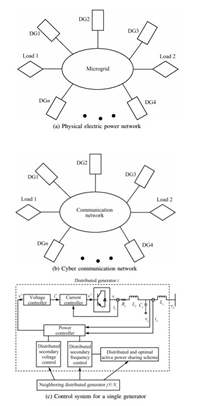
|
Download:
|
| Fig.1. A fully distributed microgrid control system. | |
| $ \omega_{i}=\omega_{ni}-m_{Pi}P_{i}, $ | (1) |
| $ v_{odi}^{*}=V_{ni}-n_{Qi}Q_{i}, $ | (2) |
| $ v_{oqi}^{*}=0, $ | (3) |
where $\omega_{i}$ and $v_{odi}^{*}$ are the reference frequency and magnitude of DG output voltage,respectively. $m_{Pi}$ and $n_{Qi}$ are the droop coefficients. $\omega_{ni}$ and $V_{ni}$ are the primary control references. $P_{i}$ and $Q_{i}$ are the measured active and reactive powers at the DGs terminal,which are generated by a low pass filter with cutoff frequency equal to $\omega_{ci}$. The differential equation of the power controller can be written as
| $ \dot{P}_{i}=-\omega_{ci}P_{i}+\omega_{ci}(v_{odi}i_{odi}+v_{oqi}i_{oqi}), $ | (4) |
| $ \dot{Q}_{i}=-\omega_{ci}Q_{i}+\omega_{ci}(v_{oqi}i_{odi}-v_{odi}i_{oqi}), $ | (5) |
where $v_{odi}$,$v_{oqi}$,$i_{odi}$,and $i_{oqi}$ are the direct and quadratic components of output voltage and output current,respectively.

|
Download:
|
| Fig.2. Power controller. | |
Remark 1. The cyber communication network can be different from the physical electric power network. A sparse communication network can be designed such that the complexity of the whole systems is reduced. The sparse communication network is accommodated by utilizing the following distributed secondary and tertiary control strategies.
III. DISTRIBUTED SECONDARY VOLTAGE AND FREQUENCY CONTROL A. Distributed Secondary Voltage ControlSince the dynamics of the voltage and current controllers are much faster than the dynamics of the power controller[5, 9],the voltage droop characteristics can be written as
| $ v_{odi}=V_{ni}-n_{Qi}Q_{i},~~~~~ v_{oqi}=0. $ | (6) |
The amplitude of the DG output voltage is
| $ v_{oi}=\sqrt{v_{odi}^{2}+v_{oqi}^{2}}=v_{odi}. $ | (7) |
Thus,the synchronization of the voltage amplitude can be achieved by choosing the control input $V_{ni}$,such that $v_{odi}\rightarrow{v_{ref}}$,where $v_{ref}$ is the output voltage magnitude reference. Differentiating the voltage-droop characteristic in (6) yields
| $ \begin{align} \dot{v}_{odi}=\dot{V}_{ni}-n_{Qi}\dot{Q}_{i}=u_{i}, \end{align} $ | (8) |
where $u_{i}$ is an auxiliary controller to be designed. The secondary voltage control input $V_{ni}$ can be calculated based on the auxiliary control input $u_{i}$. Since the microgrid structure is distributed and there is no central controller,only a subset of DGs has access to the voltage magnitude reference. To achieve the synchronization for $v_{odi}$,the distributed cooperative control schemes are applied such that the auxiliary controller is constructed by only using the own information of each DG and the information of its neighbors. The distributed algorithm can realize the plug-and-play capability of microgrid. A graph is used to describe the communication topology in microgrids. DGs are considered as the nodes of the communication graph. The edges of the graph denote the communication links. A graph is usually expressed as $G=(\nu,\varepsilon,A)$ with a non-empty finite set of $n$ nodes,a set of edges $\varepsilon\subset \nu\times \nu$,and the associated adjacency matrix $A=[a_{ij}]\in $R$^{n\times n}$, where $a_{ii}=0$ and $a_{ij}\geq0$ for all $i\neq j$. $a_{ij}>0$ if and only if there is an edge between vertex $j$ and vertex $i$. $N_{i}=\{j\in \nu:(j,i)\in\varepsilon\}$ denotes the set of the neighbors of node $i$. A diagonal matrix $D$ $=$ ${\rm diag}\{d_{i}\}$ with $d_{i}=\sum\nolimits_{j\in N_{i}}a_{ij}$ is called a degree matrix of $G$. The matrix $L=D-A$ is called the Laplacian matrix. A path is a sequence of edges of the form $(i_1, i_2)$,$(i_2,i_3)$,$...$,where $i_j\in \nu$. A graph is called connected if there exists a path between any distinct pair of nodes.
Let the node with index 0 denote the virtual leader which provides the voltage reference value. According to (8),we have
| $ \begin{aligned} v_{od0}&=v_{ref},\\ \dot{v}_{od1}&=u_{1},\\ &\vdots\\ \dot{v}_{odn}&=u_{n}. \end{aligned} $ | (9) |
Let $sig(x)^{\alpha}={\rm sign}(x)|x|^{\alpha}$,where $x\in {\bf R}$,$\alpha >0$,and ${\rm sign}(\cdot)$ denotes the signum function. For any vectors $p$ $=(p_{1},p_{2},...,p_{n})^{\rm T}$ and $q=(q_{1},q_{2},...,q_{n})^{\rm T}$,denote $p\odot q=(p_{1}q_{1},p_{2}q_{2},...,p_{n}q_{n})^{\rm T}$. For a vector $x=(x_{1}$,$...$,$x_{n})^{\rm T}$,${ sig}(x)^{\alpha}={\rm sign}(x)\odot|x|^{\alpha}$ with ${\rm sign}(x)=$ $({\rm sign}(x_{1})$,${\rm sign}(x_{2}),...,{\rm sign}(x_{n}))^{\rm T}$ and $|x|^{\alpha}=(|x_{1}|^{\alpha},|x_{2}|^{\alpha}$,$...$, $|x_{n}|^{\alpha})^{\rm T}$. Note that $sig(x)^{\alpha}$ is a continuous function with respect to $x$ when $\alpha$ is bigger than 0.
To guarantee the finite-time synchronization of the voltage control systems,the following distributed controller is proposed
| $ \begin{align} u_{i}=sig\left(\sum_{j\in N_{i}}a_{ij}(v_{odj}-v_{odi})+ b_{i}(v_{ref}-v_{odi})\right)^{\frac{1}{2}}, \end{align} $ | (10) |
where $b_{i}\geq0$ is the weight of the edge by which the $i$-th DG has access to the voltage reference. Let
| $ \begin{align} y_{i}=\sum_{j\in N_{i}}a_{ij}(v_{odj}-v_{odi})+b_{i}(v_{ref}-v_{odi}). \end{align} $ | (11) |
Furthermore,we have
$$ \begin{align*} y=-(L+B)(v_{od}-1_{n}v_{ref}), \end{align*} $$where $y=(y_{1},y_{2},...,y_{n})^{\rm T}$, $v_{od}=(v_{od1},v_{od2},...,v_{odn})^{\rm T}$,$B$ $=$ ${\rm diag}\{b_{i}\}$ is a diagonal matrix with the $i$-th entry being $b_{i}$,and $1_{n}$ denotes the $n$-th vector with all the entries being 1.
The following lemmas are required in the subsequent analysis.
Lemma 1[15]. If the graph $G$ is undirected and connected,then $L+B$ is positive definite.
Lemma 2[18]. Let the graph $G$ be connected and $B\neq0$. Then
| $ \begin{align} \|v_{od}-1_{n}v_{ref}\|\leq\frac{\|y\|}{\sigma_{\min}(L+B)}, \end{align} $ | (12) |
with $\sigma_{\min}(L+B)$ as the minimum singular value of $L+B$, and $y=0$ if and only if the output voltages of each DG synchronize,that is,$v_{od}=1_{n}v_{ref}$.
Lemma 3[19]. Let $r_{1},r_{2},...,r_{n}\geq0$ and let $0 < \rho\leq1$,then $\left(\sum\nolimits_{i=1}^{n}r_{i}\right)^{\rho}\leq\sum\nolimits_{i=1}^{n}r_{i}^{\rho}$.
Lemma 4[20]. Consider the continuous function $\dot{x}=f(x)$ with $f(0)=0$. Suppose that there is $C^{1}$ function $V(x)$ defined on a neighborhood of the origin,and there are real numbers $c$ $>$ $0$ and $0 < \alpha < 1$ such that $V(x)>0$ and $\dot{V}(x)$ $+$ $cV^{\alpha}(x)$ $\leq$ $0$. Then the origin of the system is locally finite-time stable. Moreover,the settling time,depending on the initial state $x(0)=x_{0}$,satisfies $T(x_{0})\leq\frac{V^{1-\alpha}(x_{0})}{c(1-\alpha)}$.
Now we give one of the main results.
Theorem 1. Consider the secondary voltage control system (8). Let the communication topology be connected and $b_{i}\neq0$ for at least one DG. Under the auxiliary control input $u_{i}$ given in (10),the output voltage direct term $v_{odi}$ of each DG synchronizes with the reference value $v_{ref}$ in finite time.
Proof. Choose the Lyapunov function
| $ \begin{align} V=\sum_{i=1}^{n}\int_{0}^{y_{i}}sig(\xi)^{\frac{1}{2}}{\rm d}\xi. \end{align} $ | (13) |
It is obvious that $V\geq 0$ and $V=0$ if and only if $y=(y_1$, $y_2$,$...$,$y_n)^{\rm T}=0$. The time derivative of $V$ is
| $ \begin{align} \dot{V}=&\ \sum\limits_{i=1}^{n}sig(y_{i})^{\frac{1}{2}}\dot{y}_{i}\notag \\ =& -sig(y^{\rm T})^{\frac{1}{2}}(L+B)sig(y)^{\frac{1}{2}}. \end{align} $ | (14) |
According to Lemma 1,one has that $L+B$ is positive definite as long as $b_{i}\neq0$ for at least one DG. Denote the smallest eigenvalue of $L+B$ as $\lambda_{1}(L+B)$. Suppose that $V$ $\neq$ $0$,i.e.,$y\neq0$. Thus,we have
| $ \begin{align} \dot{V}=& -\frac{sig(y^{\rm T})^{\frac{1}{2}}(L+B)sig(y)^{\frac{1}{2}}}{sig(y^{\rm T})^{\frac{1}{2}} sig(y)^{\frac{1}{2}}}\notag\\[2mm] &\ \times\frac{sig(y^{\rm T})^{\frac{1}{2}}sig(y)^{\frac{1}{2}}}{V^{\frac{2}{3}}}\times{V^{\frac{2}{3}}}\notag\\[2mm] & \leq -\lambda_{1}(L+B)\times\frac{sig(y^{\rm T})^{\frac{1}{2}}sig(y)^{\frac{1}{2}}}{V^{\frac{2}{3}}} \times{V^{\frac{2}{3}}}. \end{align} $ | (15) |
For the second term on the right side of (15),one has
| $ \begin{align} \frac{sig(y^{\rm T})^{\frac{1}{2}}sig(y)^{\frac{1}{2}}}{V^{\frac{2}{3}}}= \frac{sig(y^{\rm T})^{\frac{1}{2}}sig(y)^{\frac{1}{2}}} {\left(\sum\limits_{i=1}^{n}\frac{2}{3}|y_{i}|^{\frac{3}{2}}\right)^{\frac{2}{3}}}. \end{align} $ | (16) |
Applying Lemma 3 yields
| $ \begin{align} \frac{sig(y^{\rm T})^{\frac{1}{2}}sig(y)^{\frac{1}{2}}} {V^{\frac{2}{3}}}\geq\frac{\sum\limits_{i=1}^{n}|y_{i}|} {\sum\limits_{i=1}^{n}\left(\frac{2}{3}\right)^{\frac{2}{3}}|y_{i}|}. \end{align} $ | (17) |
According to (15) and (17),one has
| $ \begin{align} \dot{V}\leq-\lambda_{1}(L+B)\times\left(\frac{3}{2}\right)^{\frac{2}{3}}\times{V^{\frac{2}{3}}}. \end{align} $ | (18) |
By Lemma 4,we get that $V=0$,i.e.,$y=0$ as $t\geq\frac{3V^{1/3}(0)}{\left(\frac{3}{2}\right)^{2/3}\lambda_{1}(L+B)}$. Applying Lemma 2 yields that $v_{odi}=v_{ref}$ as $t\geq\frac{3V^{1/3}(0)}{\left(\frac{3}{2}\right)^{2/3}\lambda_{1}(L+B)}$, that is,the output voltage direct term $v_{odi}$ of each DG synchronizes with the reference value $v_{ref}$ in finite time.
As long as the auxiliary controller $u_i$ is designed,the secondary voltage control input $V_{ni}$ can be calculated as follows
| $ \begin{align} V_{ni}=\int(n_{Qi}\dot{Q}_{i}+u_{i}){\rm d}t. \end{align} $ | (19) |
The frequency droop characteristic is given by
| $ \begin{align} \omega_{i}=\omega_{ni}-m_{Pi}P_{i}, \end{align} $ | (20) |
where $\omega_{ni}$ is the primary frequency control reference and $m_{Pi}$ is the frequency-active power droop coefficient. The secondary frequency control is to design the control reference $\omega_{ni}$ such that the frequency of each DG synchronizes with the nominal value $\omega_{ref}$. Differentiating (20) yields
| $ \begin{align} \dot{\omega_{i}}=\dot{\omega}_{ni}-m_{Pi}\dot{P}_{i}=\mu_{i}, \end{align} $ | (21) |
where $\mu_{i}$ is an auxiliary controller to be designed. Similar to the distributed voltage control problem,the distributed frequency control problem can be transformed into the following leader-following problem
| $ \begin{align} \begin{aligned} \omega_{0}&=\omega_{ref},\\ \dot{\omega}_{1}&=\mu_{1},\\ &\vdots\\ \dot{\omega}_{n}&=\mu_{n}.\\ \end{aligned} \end{align} $ | (22) |
Let the auxiliary control input be
| $ \begin{align} \mu_{i}=sig\left(\sum\limits_{j\in N_{i}}a_{ij}(\omega_{j}-\omega_{i})+b_{i}(\omega_{ref}-\omega_{i})\right)^{\frac{1}{2}}. \end{align} $ | (23) |
Applying the same analysis as that in the proof of Theorem 1,we get the following result.
Theorem 2. Consider the secondary frequency control system (21). Let the communication topology be connected and $b_{i}\neq0$ for at least one DG. Under the auxiliary control input $\mu_{i}$ given in (23),the output frequency $\omega_{i}$ of each DG synchronizes with the reference value $\omega_{ref}$ in finite time.
Remark 2. The distributed secondary voltage and frequency control schemes are motivated by the cooperative control theory of multi-agent systems [15$-$18]. The droop-based primary control will cause the voltage and frequency deviations from nominal values once a microgrid is islanded. The proposed secondary control schemes can restore the voltage and frequency to their nominal values in finite time.
IV. DISTRIBUTED AND OPTIMAL ACTIVE POWER SHARING SCHEMETo minimize the total cost of generation while satisfying system active-power balance requirement,we need to schedule each generator's active power output. The generation cost for the $i$-th generator can be approximated by [21]
| $ \begin{align} C_{i}(P_{i})=\alpha_{i}P_{i}^{2}+\beta_{i}P_{i}+\gamma_{i}, \end{align} $ | (24) |
where $\alpha_{i}$,$\beta_{i}$,and $\gamma_{i}$ are the cost parameters. Optimization of generation cost in microgrids can be described as
| $ \begin{align} \begin{aligned} &\min_{P_{i}} \ \ \sum\limits_{i=1}^{n}C_{i}(P_{i}),\\ & {\rm s.t.} \quad \sum\limits_{i=1}^{n}P_{i}=\sum\limits_{j=1}^{m}P_{Lj}=P_{0}, \end{aligned} \end{align} $ | (25) |
where $P_{Lj}$ is the power consumed by the load $j$ and $P_{0}$ denotes the total load in microgrid. The Lagrange function for the optimal problem in (25) can be written as
| $ \begin{align} L_{\alpha}=\sum\limits_{i=1}^{n}C_{i}(P_{i})+\eta\left(P_{0}-\sum\limits_{i=1}^{n}P_{i}\right), \end{align} $ | (26) |
where $\eta$ is the Lagrange multiplier.
From the first order optimality conditions,we have
| $ \begin{align} \frac{\partial L_{\alpha}}{\partial P_{i}}=\frac{\partial C_{i}(P_{i})}{\partial P_{i}}-\eta=2\alpha_{i}P_{i}+\beta_{i}-\eta=0. \end{align} $ | (27) |
According to (27),we get the following optimal solution
| $ \begin{align} \eta^{*}=2\alpha_{i}P_{i}^{*}+\beta_{i}, \end{align} $ | (28) |
i.e.,the optimal dispatch corresponds to the dispatch for which the incremental cost of each generator is equal to $\eta^{*}$.
From (28),we have
| $ \begin{align} P_{i}^{*}=\frac{\eta^{*}-\beta_{i}}{2\alpha_{i}}. \end{align} $ | (29) |
Note that $\sum\limits_{i=1}^{n}P_{i}^{*}=P_{0}$. Thus,
| $ \begin{align} \eta^{*}=\frac{P_{0}+\sum\limits_{i=1}^{n}\frac{\beta_{i}}{2\alpha_{i}}}{\sum\limits_{i=1}^{n}\frac{1}{2\alpha_{i}}}. \end{align} $ | (30) |
From (30),we see that the optimal value is related to the entire network information. Consider that the microgrid structure is fully distributed. This optimal value cannot be calculated directly. In what follows,we provide a distributed algorithm to solve the optimal problem (25). We first introduce some auxiliary variables $\zeta_{i}$ and consider the following transformation
| $ \begin{align} P_{i}=\sum\limits_{j=1}^{n}a_{ij}(\zeta_{j}-\zeta_{i})+\sum\limits_{k=1}^{m}d_{ik}P_{L_{k}}, \end{align} $ | (31) |
where $a_{ij}$ denotes the weight of the edge between the generator $i$ and $j$ and $d_{ik}$ represents the weight of the edge between the generators $i$ and the load $k$. $d_{ik}=1$ if the load $k$ is in the neighborhood of the generator $i$ and $d_{ik}=0$ otherwise. The cyber network is constructed so that a load just communicates with one of the nearest generator. Thus,
| $ \begin{align} \sum\limits_{i=1}^{n}\sum\limits_{k=1}^{m}d_{ik}P_{L_{k}}=P_{0}. \end{align} $ | (32) |
According to (31) and (32),we have
| $ \begin{align} \sum\limits_{i=1}^{n}P_{i}=\sum\limits_{i=1}^{n} \sum\limits_{j=1}^{n}a_{ij}(\zeta_{j}-\zeta_{i})+\sum\limits_{i=1}^{n}\sum\limits_{k=1}^{m}d_{ik}P_{L_{k}}=P_{0}, \end{align} $ | (33) |
which implies the constraint in (25) is satisfied.
Now we are ready to present one of the main results. The following distributed algorithm is proposed to solve the optimal dispatch problem (25).
| $ \dot{\zeta_{i}}=\eta_{i}, $ | (34) |
| $ \frac{1}{2\alpha_{i}}\dot{\eta}_{i}=\frac{1}{2}\sum\limits_{j\in N_{i}}a_{ij}(\eta_{j}-\eta_{i})+\frac{1}{2}\dot{P}_{i}, $ | (35) |
| $ P_{i}=\sum\limits_{j=1}^{n}a_{ij}(\zeta_{j}-\zeta_{i})+\sum\limits_{k=1}^{m}d_{ik}P_{L_{k}}, $ | (36) |
| $ \eta_{i}(0)=2\alpha_{i}P_{i}(0)+\beta_{i}. $ | (37) |
Theorem 3. Let the communication topology among the DGs be connected. The distributed algorithms (34)$-$(37) solve the optimal dispatch problem (25),i.e.,$\eta_{i}\rightarrow \eta^{*}$ and $P_{i}\rightarrow P_{i}^{*}$ $(i=1,2,...,n)$ exponentially. Moreover,the exponential convergence rate is not worse than
| $ \begin{align} \zeta=\frac{\lambda_{2}(L)\left(\sum\limits_{i=1}^{n}\dfrac{1}{2\alpha_{i}}\right)^{2}} {\max\left\{\dfrac{1}{2\alpha_{i}}\right\}\left(\sum\limits_{i=1}^{n}\dfrac{n}{4\alpha_{i}^{2}}\right)}, \end{align} $ | (38) |
with $\lambda_{2}(L)$ denoting the smallest nonzero eigenvalue of $L$.
Proof. According to (34) and (36),we have
| $ \begin{align} \dot{P}_{i}=\sum\limits_{j=1}^{n}a_{ij}(\dot{\zeta}_{j}-\dot{\zeta}_{i})= \sum\limits_{j\in N_{i}}a_{ij}(\eta_{j}-\eta_{i}). \end{align} $ | (39) |
Substituting (39) into (35) yields
| $ \begin{align} \frac{1}{2\alpha_{i}}\dot{\eta}_{i}=\sum\limits_{j\in N_{i}}a_{ij}(\eta_{j}-\eta_{i}). \end{align} $ | (40) |
Let $\Lambda={\rm diag}\left\{\frac{1}{2\alpha_{i}}\right\}$ and $\eta=(\eta_{1},\eta_{2},...,\eta_{n})^{\rm T}$. Equation (40) can be rewritten in a compact form as
| $ \begin{align} \dot{\eta}=-\Lambda^{-1}L\eta. \end{align} $ | (41) |
Furthermore
| $ \begin{align} \eta={\rm e}^{-\Lambda^{-1}Lt}\eta(0). \end{align} $ | (42) |
Since the matrix $\Lambda^{-1}L$ is still a valid Laplacian matrix, it has a simple zero eigenvalue and all the other eigenvalues have positive real part. Let $J$ be the Jordan form associated with the matrix $\Lambda^{-1}L$,i.e.,$\Lambda^{-1}L=UJU^{-1}$. We have ${\rm e}^{-\Lambda^{-1}Lt}=U{\rm e}^{-Jt}U^{-1}$ and ${\rm e}^{-Jt}\rightarrow\left[\begin{array}{cc} 1 & 0_{1\times(n-1)} \\ 0_{(n-1)\times1} & 0_{(n-1)\times(n-1)} \\ \end{array} \right] $ as $t\rightarrow\infty$. Let $\omega_{r}=\left(\begin{array}{c} 1 \\ \vdots \\ 1 \end{array}\right)_{n\times1} $ and $\omega_{l}=\left(\frac{\frac{1}{2\alpha_{1}}}{\sum\limits_{i=1}^{n}\frac{1}{2\alpha_{i}}}, \frac{\frac{1}{2\alpha_{2}}}{\sum\limits_{i=1}^{n}\frac{1}{2\alpha_{i}}},..., \frac{\frac{1}{2\alpha_{n}}}{\sum\limits_{i=1}^{n}\frac{1}{2\alpha_{i}}}\right)^{\rm T}$. It is obvious that $\omega_{r}$ and $\omega_{l}$ are the right and left eigenvectors of the matrix $\Lambda^{-1}L$ associated with the eigenvalue 0,respectively. We can set $\omega_{r}$ as the first column of $U$ and $\omega_{l}^{\rm T}$ as the first row of $U^{-1}$. Thus,$U{\rm e}^{-Jt}U^{-1}=\omega_{r}\omega_{l}^{\rm T}$ as $t\rightarrow\infty$,i.e.,
| $ \begin{align} \eta\rightarrow\dfrac{\sum\limits_{i=1}^{n}\dfrac{1}{2\alpha_{i}} \eta_{i}(0)}{\sum\limits_{i=1}^{n}\frac{1}{2\alpha_{i}}} \left(\begin{array}{c} 1 \\ \vdots \\ 1 \end{array}\right)_{n\times1}. \end{align} $ | (43) |
Substituting (37) into (43),we have
| $ \begin{align} \eta\rightarrow\dfrac{P_{0}+\sum\limits_{i=1}^{n}\dfrac{\beta_{i}}{2\alpha_{i}}} {\sum\limits_{i=1}^{n}\frac{1}{2\alpha_{i}}} \left(\begin{array}{c} 1 \\ \vdots \\ 1 \end{array}\right)_{n\times1}. \end{align} $ | (44) |
That is,$\eta_{i}=\eta^{*}$ as $t\rightarrow\infty$. Integrating both sides of (35) yields
| $ \begin{align} \frac{1}{2\alpha_{i}}(\eta^{*}-\eta_i(0))=P_{i}(t)-P_{i}(0),~~~~ t\rightarrow\infty. \end{align} $ | (45) |
According to (37),one has
| $ \begin{align} P_{i}(t)=\frac{\eta^{*}-\beta_{i}}{2\alpha_{i}},~~~~ t\rightarrow\infty, \end{align} $ | (46) |
i.e.,$P_{i}=P_{i}^{*}$ as $t\rightarrow\infty$.
Next,we analyze the convergence rate of the distributed dispatch algorithm. Let $\delta=\eta-\eta^{*}\omega_{r}$. Note that $\omega_{r}^{\rm T}\Lambda\eta(t)=\omega_{r}^{\rm T}\Lambda\eta(0)$. Thus,$\omega_{r}^{\rm T}\Lambda\delta=\omega_{r}^{\rm T}\Lambda\eta(0)-\eta^{*}\omega_{r}^{\rm T}\Lambda\omega_{r}=0$. In light of (41),we have
| $ \begin{align} \dot{\delta}=-\Lambda^{-1}L\delta ,\quad\omega_{r}^{\rm T}\Lambda\delta=0. \end{align} $ | (47) |
Choose the Lyapunov function
| $ \begin{align} V=\frac{1}{2}\delta^{\rm T}\Lambda\delta. \end{align} $ | (48) |
Taking the time derivative of $V$ along (47) yields
| $ \begin{align} \dot{V}=-\delta^{\rm T}L\delta. \end{align} $ | (49) |
Let $\overline{\delta}$ be the orthogonal projection of $\delta$ on the subspace orthogonal to $\omega_{r}$. Then,$\delta$ can be decomposed into orthogonal components as $\delta=\frac{\omega_{r}^{\rm T}\delta}{n}\omega_{r}+\bar{\delta}$. Moreover,
| $ \begin{align} \dot{V}\leq-\lambda_{2}(L)\|\bar{\delta}\|^{2}, \end{align} $ | (50) |
with $\lambda_{2}(L)$ denoting the smallest nonzero eigenvalue of $L$. The norm of $\bar{\delta}$ is $\|\bar{\delta}\|=\|\delta\|\cos(\theta)$ with $\theta$ being the angle between the vectors $\delta$ and $\bar{\delta}$. Since $\theta$ is not greater than the dihedral angle $\psi$ which is equal to the angle between the normal vectors $\Lambda\omega_{r}$ and $\omega_{r}$,one has $\|\bar{\delta}\|\geq\|\delta\|\cos(\psi)=\frac{\sum\limits_{i=1}^{n}\frac{1}{2\alpha_{i}}}{\sqrt{\sum\limits_{i=1}^{n}\frac{n}{4\alpha_{i}^{2}}}}\|\delta\|$. Moreover,
| $ \begin{align} \dot{V}\leq-\lambda_{2}(L)\dfrac{\left(\sum\limits_{i=1}^{n} \dfrac{1}{2\alpha_{i}}\right)^{2}}{\sum\limits_{i=1}^{n}\dfrac{n}{4\alpha_{i}^{2}}}\|\delta\|^{2}. \end{align} $ | (51) |
Note that $\frac{1}{2}\min\left\{\frac{1}{2\alpha_{i}}\right\}\|\delta\|^{2}\leq V\leq\frac{1}{2}\max\left\{\frac{1}{2\alpha_{i}}\right\}\|\delta\|^{2}$. Thus,
| $ \begin{align} \dot{V}\leq -2\lambda_{2}(L)\dfrac{\left(\sum\limits_{i=1}^{n}\dfrac{1}{2\alpha_{i}}\right)^{2}} {\max\left\{\dfrac{1}{2\alpha_{i}}\right\}\left(\sum\limits_{i=1}^{n}\dfrac{n}{4\alpha_{i}^{2}}\right)}V, \end{align} $ | (52) |
i.e.,
| $ \begin{align} \dot{V}\leq -2\zeta V, \end{align} $ | (53) |
with $\zeta$ defined in (38). Moreover,
| $ \begin{align} \|\delta\|\leq \sqrt{\dfrac{\max\left\{\dfrac{1}{2\alpha_{i}}\right\}}{\min\left\{\dfrac{1}{2\alpha_{i}}\right\}}}{\rm e}^{-\zeta t}\|\delta(0)\|. \end{align} $ | (54) |
It is shown that the disagreement vector $\delta$ exponentially vanishes with a speed of at least $\zeta$.
To achieve the optimal active power generation in microgrid,we introduce another auxiliary control input $\tau_{i}$
| $ \begin{align} m_{P1}\dot{P}_{1}&=\tau_{1},\\ m_{P2}\dot{P}_{2}&=\tau_{2},\\ &\vdots\\ m_{Pn}\dot{P}_{n}&=\tau_{n}. \end{align} $ | (55) |
Based on the optimal generation reference $P_{i}^{*}$,the droop coefficient for the DG $i$ is set as
| $ \begin{align} m_{Pi}=\frac{\kappa}{P_{i}^{*}}, \end{align} $ | (56) |
where $\kappa$ is a positive constant.
Based on each DG own information and the information of its neighbors in the communication graph,the auxiliary controller $\tau_{i}$ is chosen as
| $ \begin{align} \tau_{i}=sig\left(\sum\limits_{j\in N_{i}}a_{ij}(m_{Pj}P_{j}-m_{Pi}P_{i})\right)^{\frac{1}{2}}. \end{align} $ | (57) |
Let $y_{i}=\sum\nolimits_{j\in N_{i}}a_{ij}(m_{j}P_{j}-m_{i}P_{i})$,$y=(y_1,y_2,..., y_n)^{\rm T}$,and $\chi=sig(y)^{1/2}$. Choose the Lyapunov function
| $ \begin{align} V=\sum\limits_{i=1}^{n}\int_{0}^{y_{i}}sig(r)^{\frac{1}{2}}{\rm d}r. \end{align} $ | (58) |
Suppose that $V\neq0$,i.e.,$y\neq0$. The time derivative of $V$ is
| $ \begin{align} \dot{V}=-\chi^{\rm T}L\chi=-\frac{\chi^{\rm T}L\chi}{\|\chi\|^{2}}\times\frac{\|\chi\|^{2}}{V^{\frac{2}{3}}} V^{\frac{2}{3}}. \end{align} $ | (59) |
Note that $\chi\notin span\{\omega_{r}\}$. The vector $\chi$ can be decomposed into orthogonal components as $\chi=\frac{\omega_{r}^{\rm T}\chi}{n}\omega_{r}+\chi_{\bot}$ with $\omega_{r}^{\rm T}\chi_{\bot}$ $=$ $0$. Thus,
| $ \begin{align} \frac{\chi^{\rm T}L\chi}{\|\chi\|^{2}}\geq\frac{\chi_{\bot}^{\rm T}L\chi_{\bot}}{\|\chi\|^{2}}\geq\lambda_{2}(L)\frac{\|\chi_{\bot}\|^{2}}{\|\chi\|^{2}}. \end{align} $ | (60) |
Since $\|\chi_{\bot}\|=\|\chi\|\cos(\theta)\geq\|\chi\|\cos(\psi)$ with $\theta$ and $\psi$ respectively denoting the angle between the vectors $\chi$ and $\chi_{\bot}$ and the dihedral angle of subspaces where these two vectors live,we have
| $ \begin{align} \dot{V}\leq-\lambda_{2}(L)\cos^{2}(\psi)\left(\frac{3}{2}\right)^{\frac{2}{3}}V^{\frac{2}{3}}. \end{align} $ | (61) |
Applying Lemma 4 yields the following result.
Theorem 4. Let the communication topology among the DGs be connected. The auxiliary controllers (57) guarantee that $m_{Pj}P_{j}=m_{Pi}P_{i}$ in finite time.
Note that $m_{Pi}=\frac{\kappa}{P_{i}^{*}}$. We further get that $P_{i}\rightarrow P_{i}^{*}$ in finite time. Thus,we get the following result.
Theorem 5. Let the communication topology among the DGs be connected. The distributed secondary frequency controller $\omega_{ni}=\int(\mu_{i}+\tau_{i}){\rm d}t$ solves the optimal active-power sharing control problem,i.e.,$P_{i}\rightarrow P_{i}^{*}$ and $\omega_{i}\rightarrow\omega_{ref}$ $(i=$ $1$,$2$, $...$,$n)$ in finite time.
V. SIMULATION STUDIESThe effectiveness of the proposed control scheme is verified by simulating an islanded microgrid in Matlab/SimPowerSystems. Fig.3 gives a microgrid test system. This microgrid consists of four DGs. The parameters of the test system are shown in Table I.
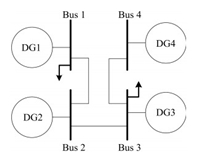
|
Download:
|
| Fig. 3. Block diagram of the microgrid test system. | |
|
|
Table I PARAMETERS OF THE MICROGRID TEST SYSTEM |
It is assumed that the DGs communicate with each other through the communication topology depicted in Fig.4. The communication topology is chosen based on the geographical location of DGs. The associated adjacency matrix of the graph in Fig.4 is
$$ \begin{align*} A=\begin{bmatrix} 0 & 1 & 0 & 0 \\ 1 & 0 & 1 & 0 \\ 0 & 1 & 0 & 1 \\ 0 & 0 & 1 & 0 \\ \end{bmatrix}. \end{align*}$$
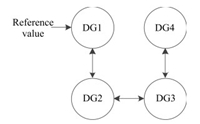
|
Download:
|
| Fig. 4. Communication topology 1. | |
DG1 is the only DG that is connected to the virtual leader node with the pinning gain of $b_{1}=1$.
The cost parameters for the DGs are given in Table II. We first calculate the optimal active power generation values for each DG. According to the centralized optimal solution shown in (30),we get the optimal incremental cost $\eta^*=16.15 \$/{\rm kW}$. The corresponding optimal active power outputs for the DGs are as follows: $P_{1}^{*}=79.44 {\rm kW}$,$P_{2}^{*}=81.69 {\rm kW}$, $P_{3}^{*}$ $=$ $64.88 {\rm kW}$,and $P_{4}^{*}=73.99 {\rm kW}$. Next we utilize the distributed optimal dispatch algorithm to solve this economic dispatch problem. Assume that this algorithm is activated at $t$ $=$ $5 {\rm s}$. Fig.5 (a) shows the incremental costs $\eta_{i}$. It is seen that the incremental costs $\eta_{i}$ converge to the same value 16.15. That is,we get the exact optimal solutions by using the proposed distributed algorithms. Fig.5 (b) shows that the active power generation references exponentially converge to the optimal values.
|
|
Table II THE DG COST PARAMETERS |
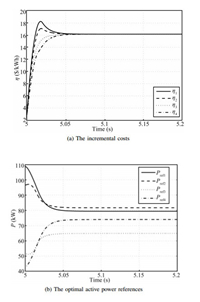
|
Download:
|
| Fig. 5. Distributed solutions for optimal active powers. | |
The nominal values for the terminal voltage $v_{ref}$ of DGs and the frequency $\omega_{ref}$ are set as 380 V and 314.16 rad/s, respectively. It is assumed that the microgrid is operated in an autonomous mode. Firstly,only the primary controllers are used. As seen from Fig.6,the values of the direct terms of the DG output voltage $v_{odi}$ and the DG terminal voltage amplitude $v_{oi}$ are less than the nominal reference $v_{ref}$. The primary voltage controller cannot avoid the deviations from the nominal values. To regulate the microgrid voltage to the nominal values,the distributed secondary voltage controllers are utilized at $t=3$ s. The direct and quadratic terms of the DG output voltages,$v_{odi}$ and $v_{oqi}$,synchronize with the nominal values 380 V and 0 V in finite time,respectively. The DG terminal voltage amplitude returns to 380 V as $t\geq 3.5$ s. Fig.7 shows the frequency of each DG before and after applying the distributed secondary frequency control. As seen from Fig.7,once the proposed secondary frequency controller is applied,the operating frequencies of the DGs converge to $\omega_{ref}$ as $t$ $\geq$ $3.5$ s. Fig.8 gives the active power outputs of the DGs. Although the demand-generation balance is guaranteed,the active power outputs of the DGs are not optimal before the optimal dispatch algorithms are activated. After the optimal dispatch algorithms are applied,we can see that the DG active power outputs converge to the optimized references in finite time.
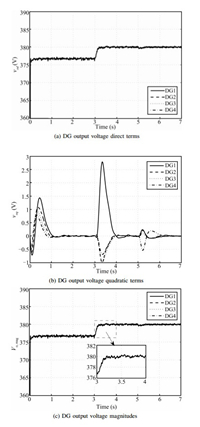
|
Download:
|
| Fig. 6. DG output voltage values. | |
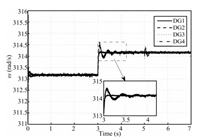
|
Download:
|
| Fig. 7. The frequency of each DG. | |
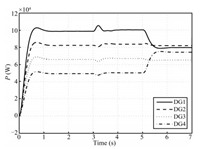
|
Download:
|
| Fig. 8. The active power output of each DG. | |
In the above case,the parameter $\alpha$ in the secondary controllers is set as ${1}/{2}$ such that the finite-time convergence is achieved. To give a comparison,another set of simulation is made under the same parameter settings except that the parameter $\alpha$ is set as 1. In this case,only the asymptotical convergence property is guaranteed. The tracking performance is shown in Fig.9. Compared with Fig.6 (c) and Fig.7,the tracking performance has become slower.
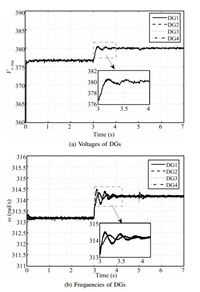
|
Download:
|
| Fig. 9. The asymptotical tracking performance. | |
The communication topology also affects the tracking performance of the secondary control systems. We assume that only DG2 has access to the reference trajectory. Fig.10 shows the communication topology. Under this scenario,the voltage output is given in Fig.11. The convergence performance is different from Fig.6 (c) because of the change of the smallest eigenvalue $\lambda_1(L+B)$ for the Laplacian matrix $L+B$.
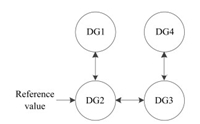
|
Download:
|
| Fig. 10. Communication topology 2. | |
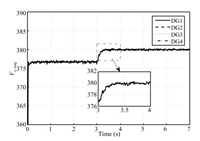
|
Download:
|
| Fig. 11. The voltage tracking performance. | |
A new control structure for autonomous microgrid was proposed in this paper. The distributed secondary voltage control module,the optimal active power sharing module,and the distributed secondary frequency control module were proposed to enable plug-and-play functionality of microgrids. The whole system was fully distributed such that each generator only requires its own information and the information of its neighbors. Different from the previous work,the optimal power sharing properties of the primary droop controllers are achieved and the satisfactory dynamic performances of the secondary controllers are guaranteed.
| [1] | Lasseter R H, Paigi P. Microgrid:a conceptual solution. In:Proceedings of the 35th IEEE Annual Power Electronics Specialists Conference. Aachen, Germany:IEEE, 2004, 6:4285-4290 |
| [2] | Lasseter R H, Piagi P. Control and Design of Microgrid Components. Project Report, New York:Power Systems Engineering Research Center Publication, 2006. |
| [3] | Chandorkar M C, Divan D M, Adapa R. Control of parallel connected inverters in standalone AC supply systems. IEEE Transactions on Industry Applications, 1993, 29(1):136-143 |
| [4] | Mohamed Y A-R I, El-Saadany E F. Adaptive decentralized droop controller to preserve power sharing stability of paralleled inverters in distributed generation microgrids. IEEE Transactions on Power Electronics, 2008, 23(6):2806-2816 |
| [5] | Pogaku N, Prodanovi M, Green T C. Modeling, analysis and testing of autonomous operation of an inverter-based microgrid. IEEE Transactions on Power Electronics, 2007, 22(2):613-625 |
| [6] | Peas Lopes J A, Moreira C L, Madureira A G. Defining control strategies for microgrids islanded operation. IEEE Transactions on Power Systems, 2006, 21(2):916-924 |
| [7] | Li Y W, Kao C N. An accurate power control strategy for power electronics-interfaced distributed generation units operating in a lowvoltage multibus microgrid. IEEE Transactions on Power Electronics, 2009, 24(12):2977-2988 |
| [8] | Marwali M N, Jung J W, Keyhani A. Stability analysis of load sharing control for distributed generation systems. IEEE Transactions on Energy Conversion, 2007, 22(3):737-745 |
| [9] | Biddram A, Davoudi A, Lewis F L, Qu Z H. Secondary control of microgrids based on distributed cooperative control of multi-agent systems. IET Generation, Transmission and Distribution, 2013, 7(8):822-831 |
| [10] | Guerrero J M, Vasquez J C, Matas J, de Vicuña L G, Castilla M. Hierarchical control of droop-controlled AC and DC microgrids-a general approach toward standardization. IEEE Transactions on Industrial Electronics, 2011, 58(1):158-172 |
| [11] | Savaghebi M, Jalilian A, Vasquez J C, Guerrero J M. Secondary control scheme for voltage unbalance compensation in an islanded droopcontrolled microgrid. IEEE Transactions on Smart Grid, 2010, 3(2):797-807 |
| [12] | Simpson-Porco J W, Dörfler F, Bullo F. Synchronization and power sharing for droop-controlled inverters in islanded microgrids. Automatica, 2013, 49(9):2603-2611 |
| [13] | Ilic M D, Liu S. Hierarchical Power Systems Control:Its Value in a Changing Industry. London:Springer, 1996. |
| [14] | Xin H H, Qu Z H, Seuss J, Maknouninejad A. A self-organizing strategy for power flow control of photovoltaic generators in a distribution network. IEEE Transactions on Power System, 2011, 26(3):1462-1473 |
| [15] | Ren W, Beard R W. Distributed Consensus in Multi-vehicle Cooperative Control. Berlin:Springer, 2008. |
| [16] | Chen G, Lewis F L, Xie L H. Finite-time distributed consensus via binary control protocols. Automatica, 2011, 47(9):962-1968 |
| [17] | Chen G, Yue Y L, Lin Q. Cooperative tracking control for networked Lagrange systems:algorithms and experiments. Acta Automatica Sinica, 2014, 40(11):2563-2572 |
| [18] | Chen G, Lewis F L. Distributed adaptive tracking control for synchronization of unknown networked Lagrangian systems. IEEE Transactions on Systems, Man, and Cybernetics, Part B:Cybernetics, 2011, 42(3):805-816 |
| [19] | Hardy G H, Littlewood J E, Pólya G. Inequalities. Cambridge:Cambridge University Press, 1952. |
| [20] | Bhat S P, Bernstein D S. Finite-time stability of continuous autonomous systems. SIAM Journal on Control and Optimization, 2000, 38(3):751-766 |
| [21] | Wood A J, Wollenberg B F. Power Generation, Operation, and Control. New York, NY, USA:Wiley, 1996. |
 2015, Vol.2
2015, Vol.2 


